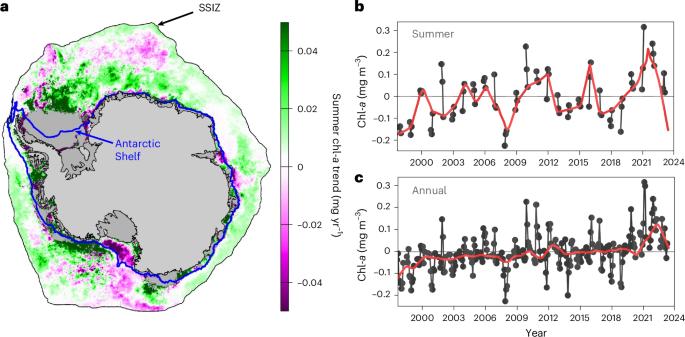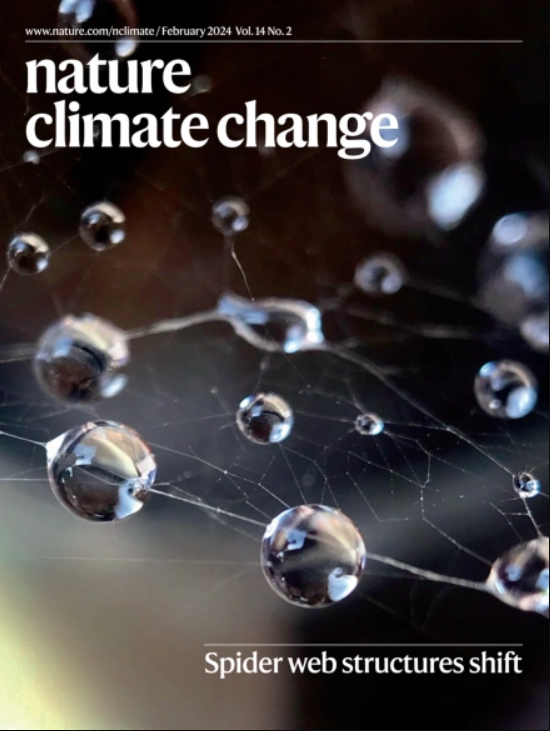南极浮游植物群落在不断变化的海冰制度下重组
IF 27.1
1区 地球科学
Q1 ENVIRONMENTAL SCIENCES
引用次数: 0
摘要
浮游植物对南极海洋食物网和相关的生物碳泵至关重要,但对其群落组成的长期变化知之甚少。在这里,我们使用机器学习框架,并结合1997年至2023年南方夏季的色素样本和环境样本,我们显示了南极洲大陆架大部分地区硅藻的减少和苔藓和隐苔藓的增加。这些与海冰增加有关的趋势在2016年之后发生了逆转,硅藻数量反弹,隐生植物数量大幅增加,与海冰的减少相吻合。在25年的数据集中,显著变化(P < 0.05)包括硅藻叶绿素a (chl-a)下降了0.32 mg chl-a m - 3(约占气体学的33%),而植被和隐植被的叶绿素a分别增加了0.08和0.23 mg chl-a m - 3。浮游植物组合的长期变化可能会减少以磷虾为中心的食物网的主导地位,并减少生物介导的碳向深海的出口,这对全球海洋碳汇有影响。本文章由计算机程序翻译,如有差异,请以英文原文为准。


Antarctic phytoplankton communities restructure under shifting sea-ice regimes
Phytoplankton are critical to the Antarctic marine food web and associated biological carbon pump, yet long-term shifts in their community composition are poorly understood. Here, using a machine learning framework and combining pigment samples and environmental samples from austral summertime 1997–2023, we show declines in diatoms and increases in haptophytes and cryptophytes across much of Antarctica’s continental shelf. These trends—which are linked to sea ice increases—reversed after 2016, with a rebound in diatoms and a large increase in cryptophytes, coinciding with the loss of sea ice. Significant changes (P < 0.05) across the 25-year dataset include diatom chlorophyll a (chl-a) declines of 0.32 mg chl-a m−3 (~33% of the climatology) and increases for haptophytes and cryptophytes of 0.08 and 0.23 mg chl-a m−3, respectively. The long-term shifts in phytoplankton assemblages could reduce the dominance of the krill-centric food web and diminish the biologically mediated export of carbon to depth, with implications for the global-ocean carbon sink. The authors use a machine learning approach and in situ pigment samples to identify summer shifts (1997–2023) in the abundance and composition of Antarctic phytoplankton. While smaller phytoplankton groups generally increased, diatom chlorophyll a broadly decreased, with putative impacts on food webs and the carbon sink.
求助全文
通过发布文献求助,成功后即可免费获取论文全文。
去求助
来源期刊

Nature Climate Change
ENVIRONMENTAL SCIENCES-METEOROLOGY & ATMOSPHERIC SCIENCES
CiteScore
40.30
自引率
1.60%
发文量
267
审稿时长
4-8 weeks
期刊介绍:
Nature Climate Change is dedicated to addressing the scientific challenge of understanding Earth's changing climate and its societal implications. As a monthly journal, it publishes significant and cutting-edge research on the nature, causes, and impacts of global climate change, as well as its implications for the economy, policy, and the world at large.
The journal publishes original research spanning the natural and social sciences, synthesizing interdisciplinary research to provide a comprehensive understanding of climate change. It upholds the high standards set by all Nature-branded journals, ensuring top-tier original research through a fair and rigorous review process, broad readership access, high standards of copy editing and production, rapid publication, and independence from academic societies and other vested interests.
Nature Climate Change serves as a platform for discussion among experts, publishing opinion, analysis, and review articles. It also features Research Highlights to highlight important developments in the field and original reporting from renowned science journalists in the form of feature articles.
Topics covered in the journal include adaptation, atmospheric science, ecology, economics, energy, impacts and vulnerability, mitigation, oceanography, policy, sociology, and sustainability, among others.
 求助内容:
求助内容: 应助结果提醒方式:
应助结果提醒方式:


